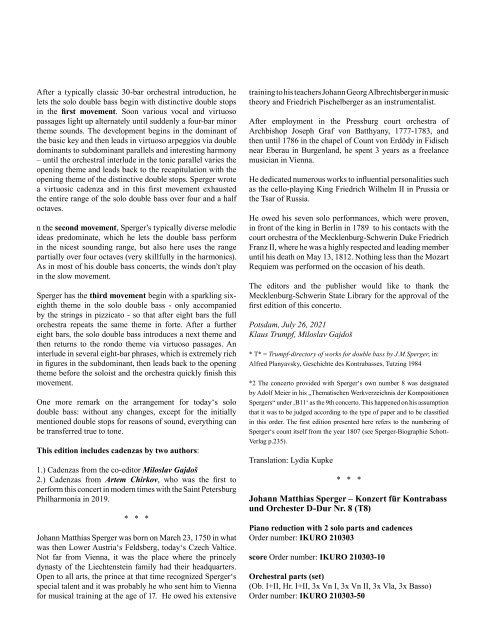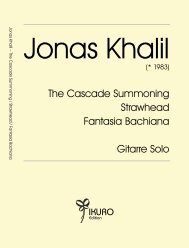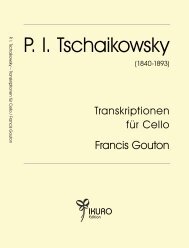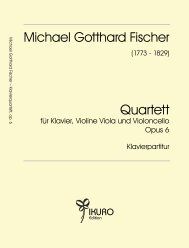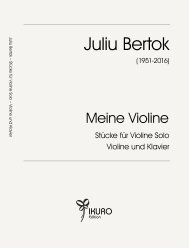IKURO 210303-10
Johann Matthias Sperger – Konzert Nr. 8 in D für Kontrabass und Orchester / Partitur
Johann Matthias Sperger – Konzert Nr. 8 in D für Kontrabass und Orchester / Partitur
Erfolgreiche ePaper selbst erstellen
Machen Sie aus Ihren PDF Publikationen ein blätterbares Flipbook mit unserer einzigartigen Google optimierten e-Paper Software.
After a typically classic 30-bar orchestral introduction, he<br />
lets the solo double bass begin with distinctive double stops<br />
in the first movement. Soon various vocal and virtuoso<br />
passages light up alternately until suddenly a four-bar minor<br />
theme sounds. The development begins in the dominant of<br />
the basic key and then leads in virtuoso arpeggios via double<br />
dominants to subdominant parallels and interesting harmony<br />
– until the orchestral interlude in the tonic parallel varies the<br />
opening theme and leads back to the recapitulation with the<br />
opening theme of the distinctive double stops. Sperger wrote<br />
a virtuosic cadenza and in this first movement exhausted<br />
the entire range of the solo double bass over four and a half<br />
octaves.<br />
n the second movement, Sperger’s typically diverse melodic<br />
ideas predominate, which he lets the double bass perform<br />
in the nicest sounding range, but also here uses the range<br />
partially over four octaves (very skillfully in the harmonics).<br />
As in most of his double bass concerts, the winds don’t play<br />
in the slow movement.<br />
Sperger has the third movement begin with a sparkling sixeighth<br />
theme in the solo double bass - only accompanied<br />
by the strings in pizzicato - so that after eight bars the full<br />
orchestra repeats the same theme in forte. After a further<br />
eight bars, the solo double bass introduces a next theme and<br />
then returns to the rondo theme via virtuoso passages. An<br />
interlude in several eight-bar phrases, which is extremely rich<br />
in figures in the subdominant, then leads back to the opening<br />
theme before the soloist and the orchestra quickly finish this<br />
movement.<br />
One more remark on the arrangement for today‘s solo<br />
double bass: without any changes, except for the initially<br />
mentioned double stops for reasons of sound, everything can<br />
be transferred true to tone.<br />
This edition includes cadenzas by two authors:<br />
1.) Cadenzas from the co-editor Miloslav Gajdoš<br />
2.) Cadenzas from Artem Chirkov, who was the first to<br />
perform this concert in modern times with the Saint Petersburg<br />
Philharmonia in 2019.<br />
* * *<br />
Johann Matthias Sperger was born on March 23, 1750 in what<br />
was then Lower Austria‘s Feldsberg, today‘s Czech Valtice.<br />
Not far from Vienna, it was the place where the princely<br />
dynasty of the Liechtenstein family had their headquarters.<br />
Open to all arts, the prince at that time recognized Sperger‘s<br />
special talent and it was probably he who sent him to Vienna<br />
for musical training at the age of 17. He owed his extensive<br />
training to his teachers Johann Georg Albrechtsberger in music<br />
theory and Friedrich Pischelberger as an instrumentalist.<br />
After employment in the Pressburg court orchestra of<br />
Archbishop Joseph Graf von Batthyany, 1777-1783, and<br />
then until 1786 in the chapel of Count von Erdödy in Fidisch<br />
near Eberau in Burgenland, he spent 3 years as a freelance<br />
musician in Vienna.<br />
He dedicated numerous works to influential personalities such<br />
as the cello-playing King Friedrich Wilhelm II in Prussia or<br />
the Tsar of Russia.<br />
He owed his seven solo performances, which were proven,<br />
in front of the king in Berlin in 1789 to his contacts with the<br />
court orchestra of the Mecklenburg-Schwerin Duke Friedrich<br />
Franz II, where he was a highly respected and leading member<br />
until his death on May 13, 1812. Nothing less than the Mozart<br />
Requiem was performed on the occasion of his death.<br />
The editors and the publisher would like to thank the<br />
Mecklenburg-Schwerin State Library for the approval of the<br />
first edition of this concerto.<br />
Potsdam, July 26, 2021<br />
Klaus Trumpf, Miloslav Gajdoš<br />
* T* = Trumpf-directory of works for double bass by J.M.Sperger, in:<br />
Alfred Planyavsky, Geschichte des Kontrabasses, Tutzing 1984<br />
*2 The concerto provided with Sperger‘s own number 8 was designated<br />
by Adolf Meier in his „Thematischen Werkverzeichnis der Kompositionen<br />
Spergers“ under ‚B11‘ as the 9th concerto. This happened on his assumption<br />
that it was to be judged according to the type of paper and to be classified<br />
in this order. The first edition presented here refers to the numbering of<br />
Sperger‘s count itself from the year 1807 (see Sperger-Biographie Schott-<br />
Verlag p.235).<br />
Translation: Lydia Kupke<br />
* * *<br />
Johann Matthias Sperger – Konzert für Kontrabass<br />
und Orchester D-Dur Nr. 8 (T8)<br />
Piano reduction with 2 solo parts and cadences<br />
Order number: <strong>IKURO</strong> <strong>2<strong>10</strong>303</strong><br />
score Order number: <strong>IKURO</strong> <strong>2<strong>10</strong>303</strong>-<strong>10</strong><br />
Orchestral parts (set)<br />
(Ob. I+II, Hr. I+II, 3x Vn I, 3x Vn II, 3x Vla, 3x Basso)<br />
Order number: <strong>IKURO</strong> <strong>2<strong>10</strong>303</strong>-50


